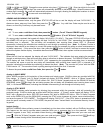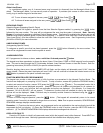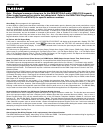
X GEM-P1664 Installation Instructions
L NAPCO Security Systems
WI1424A 1/06
Page 28
Alarm Outputs
In UL installations, (1) see Time Selection for timeout requirements; (2) Fire zones must be programmed for PulseAlarm Output, and
the option "Change Pulse Alarm to Cadenced Alarm" must be programmed. Note: For PGM1 and PGM2 are Lug Active-Low
Outputs.
Alarm; Alarm Restore Telco 1/Telco 3 See Report Telco 1/Telco 3
Alarm; Alarm Restore Telco 2 See Backup Report on Telco 2
Alarm Supervisory
An Alarm Supervisory indicates that there is an open in the circuit to the Alarm (Bell) Output and requires immediate attention. A
2.2K EOL resistor is required. See wiring diagram.
Ambush (Keypad Ambush); Ambush Codes; Enable Global Ambush
There are two types of Ambush Codes: (1) A 2-digit code (prefix) that is entered immediately prior to (and as part of) the regular User
Code and (2) A separate and unique User Code. Disarming with an Ambush Code will cause a silent report to be sent to a central
station. Thus, should a user be forced to disarm, he can silently signal an emergency while appearing to be merely disarming the
system. The Ambush Zone will automatically report when programmed to report an alarm.
Ambush Type 1: (a 2-digit prefix code), this type must not be used in a SIA CP-01 compliant system. Enable as follows: (a) select
"Ambush to Report Event Telco 1/Telco 3"; (b) select "Enable Global Ambush Code"; enter "Global Ambush Code"; and (c) enter an
"Ambush CS Report Code". Each keypad is enabled for "Ambush" individually.
Ambush Type 2: (a separate and unique user code), this type must be used in a SIA CP-01 compliant system. Enable as follows: In
the Easy Menu Driven Program Mode, the menu selection "Enter User Code" is used to program a user code with a "blank(•) 5" in
the area for which the Ambush Code will be used. Enable all other locations and program as follows: (a) select "Ambush to Report
Event Telco 1/Telco 3"; (b) enter an "Ambush CS Report Code". Each keypad is enabled for "Ambush" individually.
Be sure to inform the user what their Ambush Code is, and that the Arm/Disarm Code must be entered less than 10 seconds after the
Ambush Code for an ambush report to be sent. When "ENABLE GLOBAL AMBUSH" is selected and no Ambush code has been
entered and the keypads have been selected for AMBUSH, then the AMBUSH CODE will default to "99".
Answering Machine Pickup Without Line Seizure See Callback-Method Download.
Anti-Jam Communicator Time
If the communicator does not detect a dial tone within 12 seconds, the Anti-Jam feature will be activated. That is, the communicator
will go off line for a 16-second anti-jam interval in order to free the telephone circuit from an incoming call, then make another 12-
second attempt at dial-tone detection. If still unsuccessful, the communicator will again go off line for 16 seconds, then proceed to
dial anyway.
Areas; Zone Area 1–Zone Area 4; Priority Area Arming
Although the default program will automatically set up Zones 1 through 8 for Zone Area 1, the panel may be partitioned into two
areas. Every zone must be assigned to at least one area to be used. At least one zone must be assigned to Area 1. If a zone is
selected for both areas, that common zone will not arm until both areas are armed. If any area disarms, the common zone will
disarm.
Keypad Area Assignments
Silencing Alarm Area (determines which alarms an area may silence);
Subscriber Opening/Closing ID Numbers and Event ID Numbers (if reporting);
System Trouble Subscriber ID Number
If "Priority Area Arming" is selected, the Priority Area must be armed before the Arming Area can be armed.
Auto-Arm if not closed at end of Window; Closing Window; Fail to Close (Not for UL Installations)
AUTO-ARM can be programmed to arm at a specific closing Time (such as: 17:00 representing 5:00 pm), for a notification length of
time (such as: 00:02 representing 2 minutes), and a FAIL-TO-CLOSE has been enabled for a specific day of the week and area, and
Glossary
OUTPUT WIRING REMARKS
Alarm Output (Burg.) 3(+) & 4(–)
Single Bell Output; program Alarm Output for Burg. See System Options in the Programming Instructions WI1422 and WI1423.
Pulse Alarm Output
(Pulsed)
3(+) & 4(–)
Single Bell Output; program Pulsed Output for Fire. See System Options in the Programming Instructions WI1422 and WI1423.
PGM1 Output 5(+) & 7(-)
Programmable Output. See System Options in the Programming Instructions WI1422 and WI1423.
PGM2 Output 5(+) & 8(-)
Programmable Output. See System Options in the Programming Instructions WI1422 and WI1423.


















